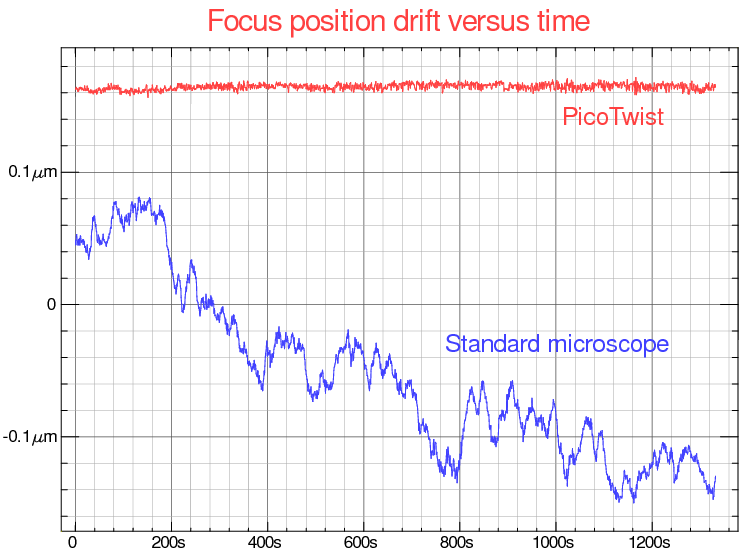Nanomanipulation experiments will typically analyze the behavior of a
protein acting on a DNA molecule for times ranging from below one
second up to several days. During this time the apparatus will track
nanometer changes in the conformation of the DNA molecule. One of the
great obstacles to nanomanipulation is microscope drift which pollutes
the enzyme signal. Standard microscopes have not been designed to
observe small objects for long times and certainly not to record their
position with nanometer accuracy. Most of the time mechanical drift is
induced by temperature changes, and most microscope manufacturers do
not even supply the drift amplitude caused by a temperature change of
one degree celsius. It turns out to be quite large, typically 1 μm per
degree Celsius, thus a change of one 1/100 �C is enough to
simulate a 10 nm change of extension. Of course one can stabilize the
temperature of the room but it is a difficult proposition to achieve a
regulation with 1/100 �C in accuracy.
At PicoTwist, we have therefore built our magnetic tweezer around a
new kind of microscope in which thermal drifts have been
minimized. The PicoTwist microscope is based on a 100x oil
immersion microscope objective which is placed in a compact metallic
housing with the sample placed on top. The design automatically
compensates thermal drifts of the various parts. The focus position of
the objective is driven to nanometer resolution by a feedback loop
piezo translator. Finallly, the objective and sample holder are
temperature-regulated with a stability better than 1/100 �C. This has
several advantages:
-
The temperature of the sample may easily be monitored from about 10 to 55 �C with an accuracy of 1/100 �C
-
The drift induced by a temperature change of 1 �C is typically 30 nm (thirty times smaller than those of a standard microscope).
-
The focus position of the objective is set with no hysteresis in a 250 μm range.
 Comparison of the drift in focus position for a standard commercial microscope and the PicoTwist design placed in the same room and thus experiencing the same thermal environement.
<< previous next >>
Comparison of the drift in focus position for a standard commercial microscope and the PicoTwist design placed in the same room and thus experiencing the same thermal environement.
<< previous next >>


